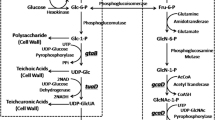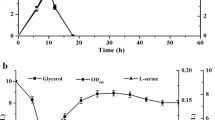Abstract
This work aimed to develop an optimal carbon source feeding strategy to achieve maximal production of heparosan as a precursor of bioengineered heparin by Escherichia coli K5. Glycerol gave higher heparosan titer and productivity compared to glucose. The maximum heparosan production (187 mg/L) and heparosan productivity (5.19 mg/L/h) in glycerol-defined medium were 26.4% higher than the heparosan production (148 mg/L) and heparosan productivity (4.11 mg/L/h) in glucose-defined medium. DO-stat feeding approach as compared to pH-stat feeding, exponential feeding, exponential combined with pH-stat feeding, and constant rate feeding gave the highest heparosan titer at 8.63 g/L, which was nine times that of batch culture. The obtained optimal glycerol feeding strategy may be useful for the scaling-up of microbial heparosan production.






Similar content being viewed by others
References
Linhardt RJ (2003) Heparin: structure and activity. J Med Chem 46:2551–2554
Liu H, Zhang Z, Linhardt RJ (2009) Lessons learned from the contamination of heparin. Nat Prod Rep 26:313–321
Bauer KA, Hawkins DW, Peters PC, Petitou M, Herbert JM, van Boeckel CAA, Meuleman DG (2002) Fondaparinux, a synthetic pentasaccharide: the first in a new class of antithrombotic agents-the selective factor Xa inhibitors. Cardiovasc Drug Rev 20:37–52
Sinay P, Jacquinet JC, Petitou M, Duchaussoy P, Lederman I, Choay J, Torri G (1984) Total synthesis of a heparin pentasaccharide fragment having high affinity for antithrombin III. Carbohydr Res 132:C5–C9
Vann WF, Schmidt MA, Jann B, Jann K (1981) The structure of the capsular polysaccharide (K5 antigen) of urinary-tract-infective Escherichia coli O10:K5:H4. A polymer similar to desulfo-heparin. Eur J Biochem 116:359–364
DeAngelis PL, White CL (2002) Identification and molecular cloning of a heparosan synthase from Pasteurella multocida type D. J Biol Chem 277:7209–7213
Kuberan B, Lech MZ, Beeler DL, Wu ZL, Rosenberg RD (2003) Enzymatic synthesis of antithrombin III-binding heparan sulfate pentasaccharide. Nature Biotech 21:1343–1346
Lindahl U, Li JP, Kusche-Gullberg M, Salmivirta M, Alaranta S, Veromaa T, Emeis J, Roberts I, Taylor C, Oreste P, Zoppetti G, Naggi A, Torri G, Casu B (2005) Generation of “Neoheparin” from E. coli K5 capsular polysaccharide. J Med Chem 48:349–352
Chen J, Avci FY, Munoz EM, McDowell LM, Chen M, Pedersen LC, Zhang L, Linhardt RJ, Liu J (2005) Enzymatic redesigning of biological active heparan sulfate. J Biol Chem 280:42817–42825
Manzoni M, Bergomi S, Cavazzoni V (1996) Production of K5 polysaccharides of different molecular weight by Escherichia coli. J Bioact Compat Polym 11:301–311
Viskov C, Lux F, Gervier R, Colas G (2008) Method for producing K5 polysaccharide. US Patent 0032349
Wang Z, Ly M, Zhang F, Zhong W, Suen A, Hickey A, Dordick JD, Linhardt RJ (2010) E. coli K5 fermentation and the preparation of heparosan, a bioengineered heparin precursor. Biotechnol Bioeng 107:964–973
Lee SY (1996) High cell density culture of Escherichia coli. Trends Biotechnol 14:98–105
Ito T, Nakashimada Y, Senba K, Matsui T, Nishio N (2005) Hydrogen and ethanol production from glycerol-containing wastes discharged after biodiesel manufacturing process. J Biosci Bioeng 100:260–265
Bitter T, Muir HM (1962) A modified uronic acid carbazole reaction. Anal Biochem 4:330–334
Kim BS, Lee SC, Lee SY, Chang YK, Chang HN (2004) High cell density fed-batch cultivation of Escherichia coli using exponential feeding combined with pH-stat. Bioprocess Biosyst Eng 26:147–150
Wang Z, Dordick JS, Linhardt RJ (2011) Escherichia coli K5 heparosan fermentation and improvement by genetic engineering. Bioeng Bugs 2:1–5
Acknowledgments
This work was financially supported the Priority Academic Program Development of Jiangsu Higher Education Institutions, the National Natural Science Foundation of China (20836003), the Major State Basic Research Development Program of China (973 Program, 2012CB720806), and the National High Technology Research and Development Program of China (863 Program, 2011AA100905), and 111 Project (111-2-06).
Author information
Authors and Affiliations
Corresponding authors
Rights and permissions
About this article
Cite this article
Liu, Y., Liu, L., Chen, J. et al. Effects of carbon sources and feeding strategies on heparosan production by Escherichia coli K5. Bioprocess Biosyst Eng 35, 1209–1218 (2012). https://doi.org/10.1007/s00449-012-0708-2
Received:
Accepted:
Published:
Issue Date:
DOI: https://doi.org/10.1007/s00449-012-0708-2




